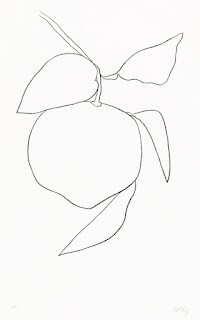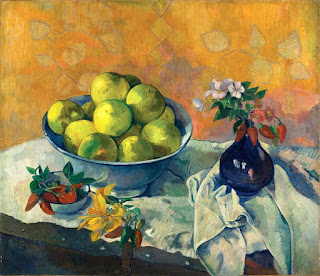~ ~ ~ ~ ~ ~ ~ ~ ~ ~ ~ ~ ~ ~ ~
Grapefruit in Art Museums
Eyes Ready to Feast On...
The museums from around the world in Greece, the US, and the UK appear in the following order:
Santa Barbara Museum of Art, Santa Barbara, California
Botany Library, Natural History Museum, London, UK
Whitney Museum of American Art, New York, New York
Denver Art Museum, Denver, Colorado
Cleveland Museum of Art, Cleveland, Ohio
Museum of Modern Art, New York, New York
Basil & Elise Goulandris Foundation, Athens, Greece
Metropolitan Museum of Art, New York, New York
Grapefruit
Edward Chalmers Leavitt (1842-1904), American
Oil on canvas, 22" x 16" (w x h)
Santa Barbara Museum of Art, Santa Barbara, California
Wiki and Bedford Fine Art Gallery edited:
Edward Chalmers Leavitt, a native of Providence, Rhode Island, attended private schools in Rhode Island and the Kimball Union Academy in Meredith, New Hampshire. It was not until he enlisted in the United States Navy during the US Civil War that he began honing his drawing skills. Leavitt studied with James Lewin, one of the Group of 1855 artists who promoted the arts in Providence. Leavitt was said to be the most renowned still life painter of his day in Providence, although today he's largely forgotten. Leavitt's work is in the collection of the Brandywine River Museum, the Cahoon Museum of American Art in Cotuit, Massachusetts, in the collection of the Cummer Museum of Art In Jacksonville, Florida, and the Santa Barbara Museum of Art, Santa Barbara, California.
2
Pompelmouse chadec /
(Cirtus paradisi) Grapefruit
Antoine Risso (1777-1845), French
Watercolor on paper
Page 65 from Histoire naturelle des Orangers
(Natural History of Orange Trees) (1818-1822)
by Antoine Risso
Botany Library, Natural History Museum, London, UK
Wiki edited:
Giuseppe Antonio Risso (1777-1845), called Antoine Risso, was a naturalist from Niçard (Nice in the Duchy of Savoy where the language was Niçard, though no longer used today.) Risso was born in Nice and studied there. He published Ichthyologie de Nice (Fish of Nice) (1810), Histoire naturelle de l'Europe méridionale (Natural History of Southern Europe) (1826) and Histoire Naturelle des Orangers (Natural History of Orange Trees) (1818-1822). He named 549 marine genera and species. Risso's dolphin is named after him, his description forming the basis of the first public description of the animal, by Georges Cuvier, in 1812.
3
Still Life with Grapefruit and Seltzer Bottle
Larry Rivers (1923-2002) American
Oil and oil stick on canvas, 36" x 28" (w x h), 1954
Whitney Museum of American Art, New York, New York
Wiki edited:
Larry Rivers, born Yitzroch Loiza Grossberg, (1923-2002) was an American artist, musician, filmmaker, and occasional actor. Rivers took up painting in 1945 and studied at the Hans Hofmann School from 1947-48. He earned a BA in art education from New York University in 1951. His work was quickly acquired by the Museum of Modern Art. Considered by many scholars to be the Godfather and Grandfather of Pop art, he was one of the first artists to merge non-objective, non-narrative art with narrative and objective abstraction. In 2002 a major retrospective of Rivers' work was held at the Corcoran Gallery of Art in Washington, D.C. New York University bought correspondences and other documents from the Larry Rivers Foundation to house in their archive. Throughout his career, Rivers maintained studios in New York City, Southampton, Long Island, and Zihuatanejo, Mexico.
4
Grapefruit and Endive
Georgia O'Keeffe (1887-1986), American
Oil on canvas, 11" x 8" (w x h), circa 1930
Denver Art Museum, Denver, Colorado
Denver Art Museum edited:
O'Keeffe traveled to New Mexico, her first trip there, in 1929 with her friend Rebecca Strand/ They stayed in Taos with Mabel Dodge Luhan, who provided the women with studios. She painted this the following year.
5
Grapefruit
Yasuo Kuniyoshi (1889-1953), Japanese-American
Watercolor on paper, 16" x 22" (w x h), 1923
Cleveland Museum of Art, Cleveland, Ohio
Wiki edited:
Yasuo Kuniyoshi (1889-1953) was a Japanese-American painter, photographer and printmaker. Born on September 1, 1889 in Okayama, Japan, in 1906, choosing not to attend military school in Japan, he immigrated to the United States. He spent some time in Seattle, before enrolling at the Los Angeles School of Art and Design. Three years later he moved to New York City and studied at the Art Students League of New York. He later taught at the Art Students League in New York City and in Woodstock, New York, were around 1930, the he built a home and studio on Ohayo Mountain Road in Woodstock.
In 1935, Kuniyoshi was awarded the Guggenheim Fellowship. He was also an Honorary member of the National Institute of Arts and Letters and first president of Artists Equity Association, now known as New York Artists Equity Association. In 1948, Kuniyoshi became the first living artist chosen to have a retrospective at the Whitney Museum of American Art. In 1952, Kuniyoshi also exhibited at the Venice Biennial.
For an unexpected surprise, see Yasuo Kuniyoshi's 1930s lithograph of South Berwick, Maine HERE.
6
Grapefruit (Pamplemousse)
Ellsworth Kelly (1923-2015), American
Lithograph, edition of 28, 20" x 16" (w x h), circa 1964-1965
from Suite of Plant Lithographs. 1964-65, 1966
Publisher: Maeght Éditeur, Paris
Museum of Modern Art, New York, New York
Intriguing Observation:
Two museums have this series of lithographs, but only one has the titles listed correctly. MOMA, New York apparently has it correct, Tangerine (Mandarine) and Grapefruit (Pamplemousse), but the MFA, Boston seems to have the titles for these two switched. MOMA list HERE. MFA List HERE, based on the leaf shapes of Tangerine and Grapefruit trees.
7
Nature morte aux pamplemousses /
Still Life with Grapefruits
Paul Gauguin (1848-1903), French
Oil on canvas, 30" x 26" (w x h), circa 1901
Basil & Elise Goulandris Foundation, Athens, Greece
Museum notes edited:
In July 1895, Paul Gauguin made his second and last voyage to Tahiti, leaving France once and for all. Driven by lack of recognition in his homeland, financial difficulties and his constant desire to flee, in July 1895, Paul Gauguin made his second and last voyage to Tahiti, leaving France once and for all.
Painting in Tahiti, the classic elements of a Western still life have been replaced by exotic flowers, peppers and grapefruits; only the treatment of the tablecloth is similar, offering the same unity, the same harmony to the whole. It's believed that Gauguin painted Still Life with Grapefruits, which for many years was entitled Still Life with Apples and Flowers, in 1901. Experts came to this conclusion based on the arrangement of objects on the leather trunk, bringing the composition close to other paintings which were carried out that same year, and on his confinement to the hospital and subsequently to his studio due to illness, when he painted without a model. He died two hears after painting this.
8
Tables for Ladies
Edward Hopper, (1882-1967) American
Oil on canvas, 60" x 48" (w x h), 1930
Metropolitan Museum of Art, New York, New York
MET notes and Wiki edited:
In Tables for Ladies, a waitress leans forward to adjust the vividly painted foods at the window as a couple sits quietly in the richly paneled and well-lit interior. A cashier attentively tends to business at her register. Though they appear weary and detached, these two women hold jobs newly available to female city dwellers outside the home. The title alludes to a recent social innovation, in which dining establishments advertised Tables for Ladies in order to welcome their newly mobile female customers.
In the past, it had often been assumed that women appearing alone in restaurants or bars were prostitutes looking for business; now, dining on their own or dining with other women, they would be treated respectfully. In addition, the date of this painting serves as a reminder that Hopper was living in New York during the Great Depression, when many Americans could not afford to dine out, even at such an unpretentious establishment as this one.









No comments:
Post a Comment